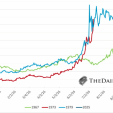Gold Ends Below USD1,300 On Positive Data
Chicago (May 15) Gold futures surrendered much of the gains made yesterday, to end below the USD1,300 -mark on Thursday, following some mixed economic data although some encouraging reports showed the US economy to be advancing well.
In some positive economic news, US consumer prices increased in line with economists' estimates in April, with prices for gasoline, shelter, and food all rising, a Labor Department report showed Thursday. Meanwhile, business conditions for New York manufacturers improved significantly in May with the index of regional manufacturing activity at its highest level in nearly four years, a report from the Federal Reserve Bank of New York said Thursday.
Activity in the Philadelphia -area manufacturing sector expanded for the third consecutive month in May, although the index of activity in the sector fell compared to the previous month.
Gold for June delivery, the most actively traded contract, dropped USD12 .30% or 0.9% to close at USD1,293.60 an ounce on the Comex division of the New York Mercantile Exchange on Thursday.
Gold for June delivery scaled an intraday high of USD1,307.30 and a low of USD1,290.90 an ounce.
On Wednesday, gold futures ended higher amid news that Germany's Bundesbank is on board with the European Central Bank's stimulus plans.
Holdings of SPDR Gold Trust , the world's largest gold-backed exchange-traded fund, remained unchanged from its previous close of 780.46 tons.
The dollar index, which tracks the US unit against six major currencies, traded at 80.04 on Thursday, down from its previous close of 80.06 late Wednesday in North American trade. The dollar scaled a high of 80.34 intraday and a low of 79.93.
The euro traded lower against the dollar at USD1.3709 on Thursday, as compared to its previous close of USD1.3715 late Wednesday in North America . The euro scaled a high of USD1.3732 intraday and a low of USD1.3649 .
In economic news from the US, the Labor Department said initial jobless claims fell to a seven-year low to 297,000, down 24,000 from the previous week's revised level of 321,000. Economists had been expecting initial jobless claims to decline to 317,000 from 319,000 in the previous week.
Homebuilder confidence in the US unexpectedly deteriorated in May, the National Association of Home Builders said in a report Thursday, with the homebuilder confidence index dropping to its lowest level in a year. The NAHB/Wells Fargo Housing Market Index edged down to 45 in May from a revised 46 in April. Economists expected the index to climb to a reading of 49 from the 47 originally reported for the previous month.
The US Labor Department said its consumer price index rose 0.3% in April after edging up by 0.2% in March. Economists expected consumer prices to rise by about 0.3%. Core consumer prices, which exclude food and energy prices, edged up by 0.2%, matching the increase seen in the previous month. Core prices had been expected to tick up by 0.1%.
A Federal Reserve Bank of New York report showed business conditions for New York manufacturers improved significantly in May, with the index of regional manufacturing activity reaching its highest level in nearly four years. The New York Fed said its general business conditions index jumped to 19.0 in May from 1.3 in April, with a positive reading indicating growth in regional manufacturing activity. Economists expected the index to climb to a reading of 5.0.
The Federal Reserve's report on US industrial production showed an unexpected 0.6% drop in output during April, following an upwardly revised 0.9% in March. Economists expected production to come in unchanged compared to the 0.7% increase originally reported for the previous month.
According to a report from the Federal Reserve Bank of Philadelphia , activity in the Philadelphia -area manufacturing sector expanded for the third consecutive month in May, although the index of activity in the sector dipped to 15.4, down from 16.6 in April. Economists expected the index to drop to a reading of 14.3.
Meanwhile, Russia's economic growth slowed significantly in the first quarter, as the fallout from the Ukraine crisis hurt the economy as investments left the country. Gross domestic product rose just 0.9% year-on-year, following 2% increase in the fourth quarter of 2013, figures from the statistical office showed Thursday. Economists expected a weaker growth figure of 0.7%. The country's economy ministry had forecast 0.8% expansion for the first quarter.












